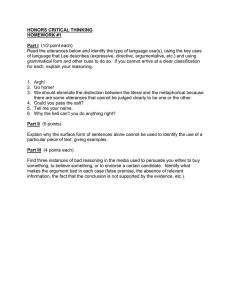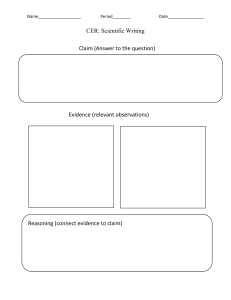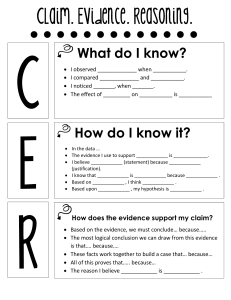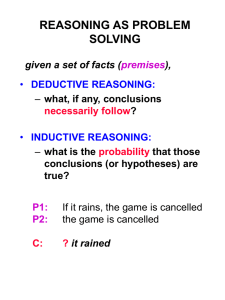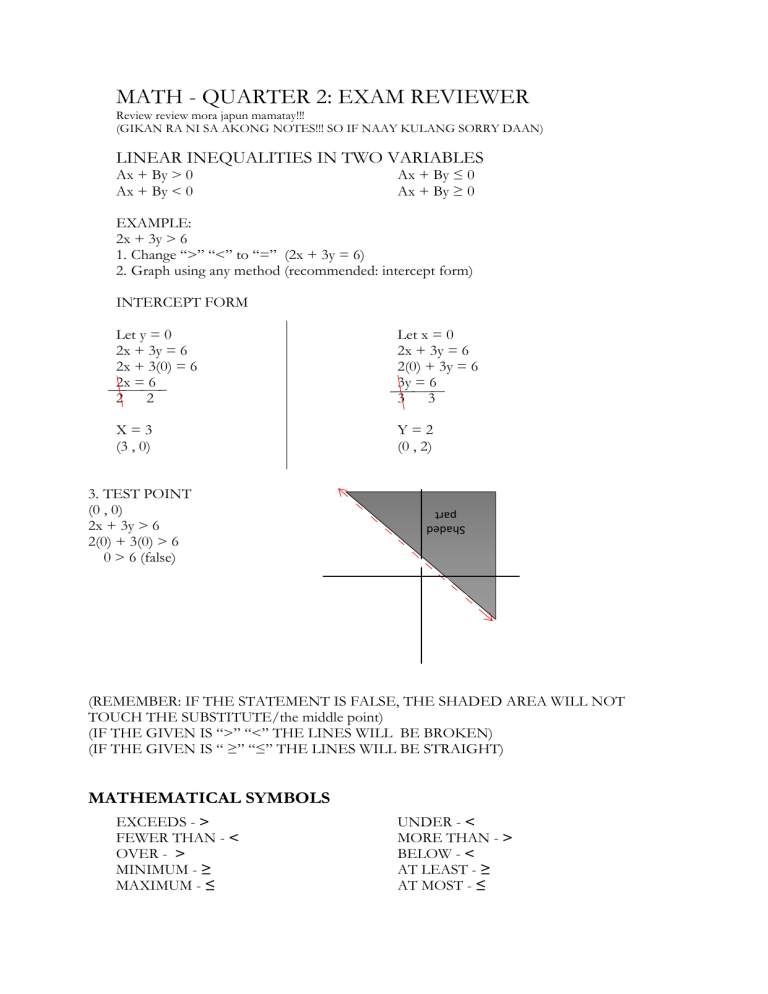
MATH - QUARTER 2: EXAM REVIEWER Review review mora japun mamatay!!! (GIKAN RA NI SA AKONG NOTES!!! SO IF NAAY KULANG SORRY DAAN) LINEAR INEQUALITIES IN TWO VARIABLES Ax + By > 0 Ax + By < 0 Ax + By ≤ 0 Ax + By ≥ 0 EXAMPLE: 2x + 3y > 6 1. Change “>” “<” to “=” (2x + 3y = 6) 2. Graph using any method (recommended: intercept form) INTERCEPT FORM Let y = 0 2x + 3y = 6 2x + 3(0) = 6 2x = 6 2 2 Let x = 0 2x + 3y = 6 2(0) + 3y = 6 3y = 6 3 3 X=3 (3 , 0) Y=2 (0 , 2) Shaded part 3. TEST POINT (0 , 0) 2x + 3y > 6 2(0) + 3(0) > 6 0 > 6 (false) (REMEMBER: IF THE STATEMENT IS FALSE, THE SHADED AREA WILL NOT TOUCH THE SUBSTITUTE/the middle point) (IF THE GIVEN IS “>” “<” THE LINES WILL BE BROKEN) (IF THE GIVEN IS “ ≥” “≤” THE LINES WILL BE STRAIGHT) MATHEMATICAL SYMBOLS EXCEEDS - > FEWER THAN - < OVER - > MINIMUM - ≥ MAXIMUM - ≤ UNDER - < MORE THAN - > BELOW - < AT LEAST - ≥ AT MOST - ≤ RELATION AND FUNCTION RELATION - A SET OF ORDERED PAIRS FUNCTION - A RELATION WHOSE ELEMENT IS THE DOMAIN THAT IS MATCHED AT EXACTLY ONE ELEMENT IN THE RANGE DOMAIN - SET OF X-COORDINATES AKA THE VALUE OF X RANGE - SET OF Y-COORDINATES AKA THE VALUE OF Y “ALL FUNCTION IS A RELATION BUT NOT ALL RELATION IS A FUNCTION” 1. (2,6) (3,4) (5, -2) D R 2 6 3 4 5 -2 2. (4,5) (3,5) (-6,5) D R 4 3 5 -6 3. (2,3) (4,6) (2,5) D R 3 2 6 4 5 FUNCTION FUNCTION RELATION (SO BASICALLY PWEDE MANGABIT SI RANGE PERO BAWAL MANGABIT SI DOMAIN) FINDING THE DOMAIN AND RANGE 1. D: ( x l x e lR) R: ( y l y e lR) 2. D: ( x l x ≥ 0) R: ( y l y e lR) 3. D: ( x l x e lR) R: ( y l y ≤ 0) l - such as e - is an element lR - of real numbers ≥ - if the line is going positive ≤ - if the line is going negative = - if the line is going straight e lR - if the line is horizontal/vertical FINDING THR DOMAIN OF A FUNCTION Easy lvl: 1. f(x) = 3x/x+2 2. f(x) = √x-2 x+2=0 x ≠ -2 D: (x l x e lR, x ≠ -2) x-2≥0 x ≥2 D: (x l x ≥ 2) 3. f(x) = x + 2 D: (x l x e lR) (if there’s no denominator, you don’t need to solve it.) Average lvl: 1. f(x) 4/x² + 6x + 8 (x+4)(x+2) = 0 = 4/(x+4)(x+2) 4 = -4 2= -2 D: (x l x e lR, x ≠ -4, -2) 2. f(x) 5/x² - 4x - 12 (x+6)(x-2) = 0 = 5/(x+6)(x-2) 6 = -6 -2 = 2 D: (x l x e lR, x ≠ 4, -4) 3. f(x) 5/x² - 16 (x-4)(x+4) = 0 =(x-4)(x+4) -4 = 4 4 = -4 D: ( x l x e lR, x ≠ 4, -4) (numbers can be at any order) Hard lvl: 1. f(x) √x² - 6x + 8 x² - 6x + 8 ≥ 0 (x-4)(x-2) = 0 -4 = 4 -2 = 2 D: (x l x ≥ 4, x ≤ 2) 2. f(x) = √x² - 9 √x² -9 (x+3)(x-3) 3 = -3 -3 = 3 D: ( x l x ≤ -3, x ≥ 3) 3. f(x) = √x² - 14x -51 (x+3)(x-17) 3 = -3 -17 = 17 D: ( x l x ≥ 17, x ≤ -3) (the numbers can also be at any order as long as the signs remain correct) LOGICAL REASONING IF - THEN STATEMENTS conditional statement - symbolized by p --> q, is an if-then statement in which p is a hypothesis and q is a conclusion. The logical connector in a conditional statement is denoted by the Symbol -> . The conditional is defined to be true unless a true hypothesis leads to a false conclusion p - hypothesis q - conclusion EXAMPLE Conditional Statement: If a car is in good condition, then it is safe for driving. Hypothesis: A car is in good condition Conclusion: It is safe for driving. INVERSE, CONVERSE, and CONTRAPOSITIVE Conditional Statement - if p then q Converse - if q then p Inverse - If not p then not q Contrapositive - If not q then not p DEDUCTIVE AND INDIDUCTIVE REASONING Inductive reasoning - a kind of reasoning where the conclusion is made based upon current knowledge, observation, examples and patterns. It uses specific examples to arrive at a general rule, generalizations or conclusions. It is judging by experience. It involves uncertainty in making conclusions. Inductive Reasoning is a process of observing data, recognizing patterns, and making generalizations from observations. EXAMPLE: My Math teacher is strict. My previous Math teacher was strict. What can you say about all math teachers? All Math teachers are strict Deductive reasoning - a type of logical reasoning that uses accepted facts to reason in a step-bystep manner until we arrive at the desired statements. From the given statement, you are to make a sound judgment or a conclusion. For a clearer thought, let us take some laws in logic that is vital in deduction. Law of Detachment (Modus Ponens) Major Premise: If p is true, then q is true. Minor Premise: p is true. Conclusion: Therefore, q is true. 1. Major Premise: If you are an 18-year old Filipino citizen, then you can vote. Minor Premise: Pete is an 18-year old Filipino. Conclusion: Therefore, Pete can vote. Law of Syllogism (Chain Rule) Major Premise: If p is true, then q is true. Minor Premise: If q is true, then r is true. Conclusion: If p, then r 1. Major Premise: If it is May, then there are many flowers. Minor Premise: If there are many flowers, then I am happy. Conclusion: If it is May, then I am happy.
